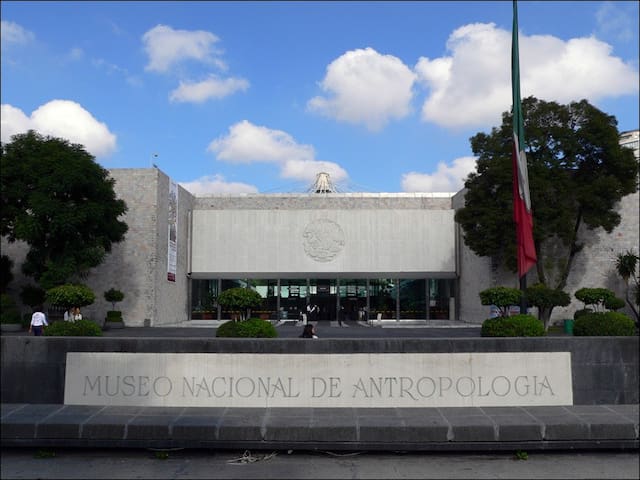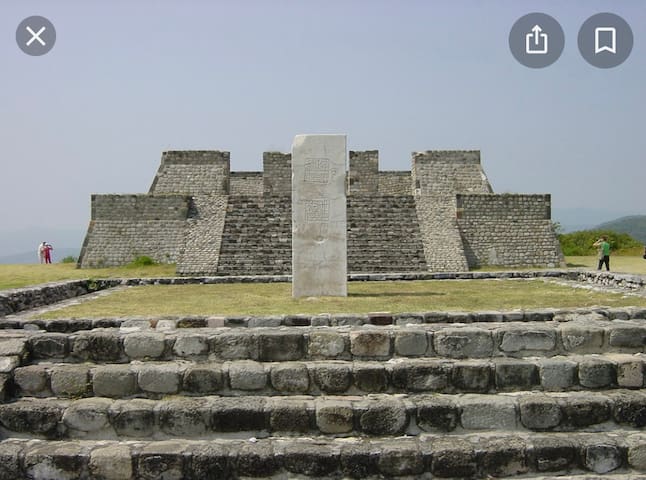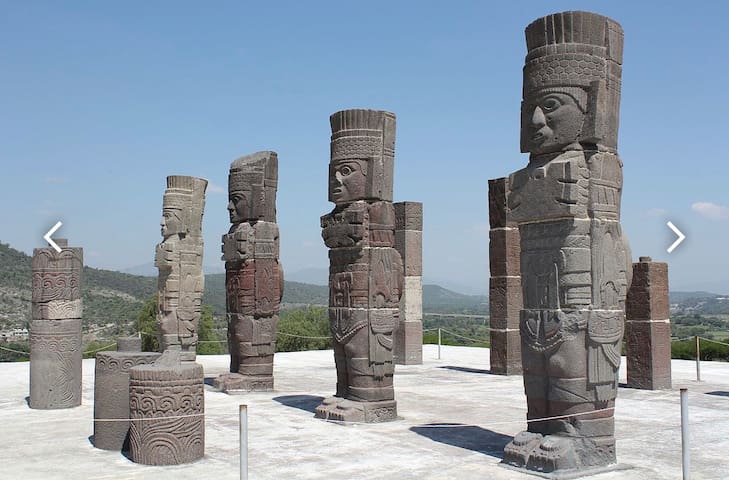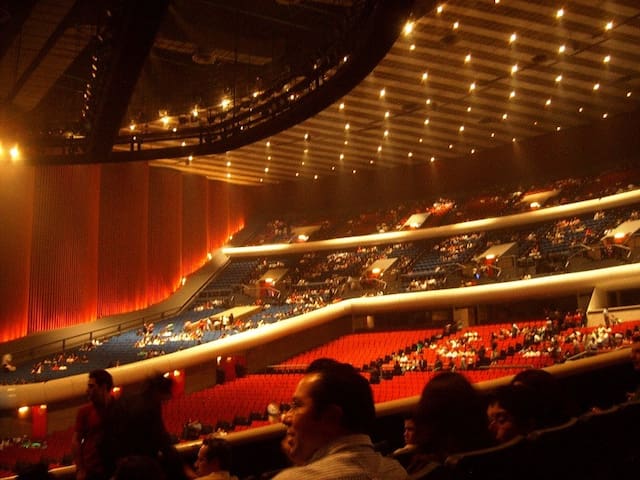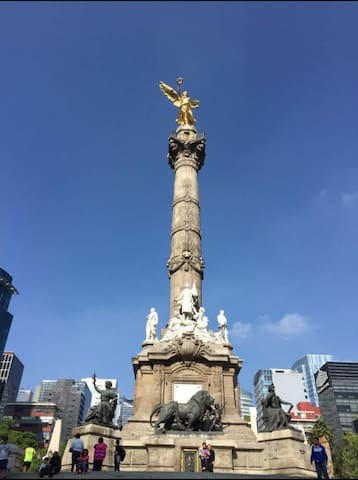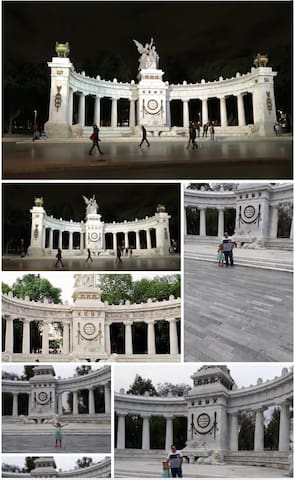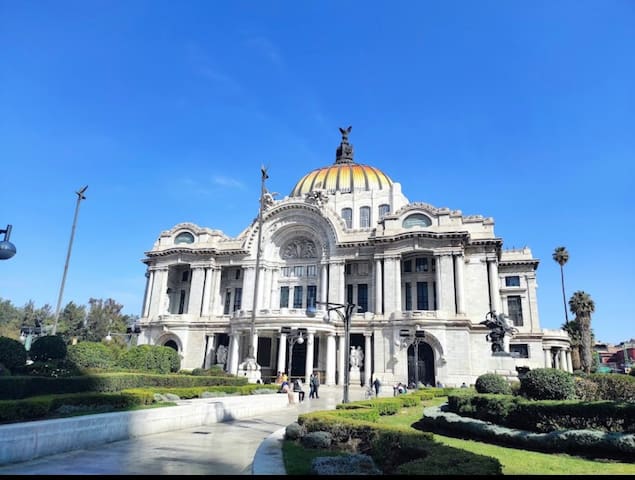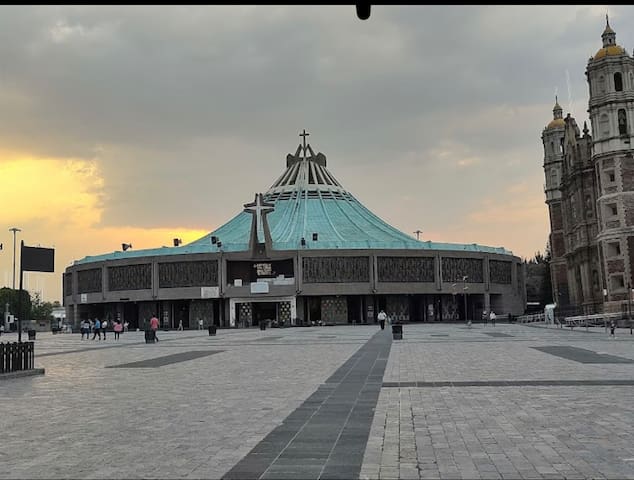Museum Contemporary Art
Museo Rufino Tamayo is a public contemporary art museum located in Mexico City's Chapultepec Park, that produces contemporary art exhibitions, using its collection of modern and contemporary art, as well as artworks from the collection of its founder, the artist Rufino Tamayo.
Very emblematic museum embedded in the Chapultepec Park, a must see
561 recommandé par les habitants
Museo Tamayo Arte Contemporáneo
51 Av. Paseo de la ReformaVery emblematic museum embedded in the Chapultepec Park, a must see
Anthropology museum
One of the best museums in Mexico City - you will get to see many item and learn about the different tribes around Mexico. The real Tlaloc statue is right there (god of rain)
The National Museum of Anthropology (Spanish: Museo Nacional de Antropología, MNA) is a national museum of Mexico. It is the largest and most visited museum in Mexico. Located in the area between Paseo de la Reforma and Mahatma Gandhi Street within Chapultepec Park in Mexico City,[3] the museum contains significant archaeological and anthropological artifacts from Mexico's pre-Columbian heritage, such as the Stone of the Sun (or the Aztec calendar stone) and the Aztec Xochipilli statue.
1503 recommandé par les habitants
Museo Nacional de Antropologia
s/n Av. Paseo de la ReformaThe National Museum of Anthropology (Spanish: Museo Nacional de Antropología, MNA) is a national museum of Mexico. It is the largest and most visited museum in Mexico. Located in the area between Paseo de la Reforma and Mahatma Gandhi Street within Chapultepec Park in Mexico City,[3] the museum contains significant archaeological and anthropological artifacts from Mexico's pre-Columbian heritage, such as the Stone of the Sun (or the Aztec calendar stone) and the Aztec Xochipilli statue.
Teotihuacán is a municipality located in the State of Mexico. The municipal seat is the town of Teotihuacán de Arista. It is in the northeast of the Valley of Mexico, 45 km northeast of Mexico City and 119 km from the state capital of Toluca. Teotihuacan takes its name from the ancient city and World Heritage site that is located next to the municipal seat. "Teotihuacan" is from Nahuatl and means "place of the gods." In Nahua mythology the sun and the moon were created here. The seal of the municipality features the Pyramid of the Sun from the archeological site, which represents the four cardinal directions. The building is tied to a character that represents water which is linked to an arm that is joined to the head of an indigenous person who is seated and speaking. This person represents a god.[1] Much of the history of the area has been tied to the ancient city, most recently involves controversy connected with commerce and development around the site
270 recommandé par les habitants
San Juan Teotihuacán
Teotihuacán is a municipality located in the State of Mexico. The municipal seat is the town of Teotihuacán de Arista. It is in the northeast of the Valley of Mexico, 45 km northeast of Mexico City and 119 km from the state capital of Toluca. Teotihuacan takes its name from the ancient city and World Heritage site that is located next to the municipal seat. "Teotihuacan" is from Nahuatl and means "place of the gods." In Nahua mythology the sun and the moon were created here. The seal of the municipality features the Pyramid of the Sun from the archeological site, which represents the four cardinal directions. The building is tied to a character that represents water which is linked to an arm that is joined to the head of an indigenous person who is seated and speaking. This person represents a god.[1] Much of the history of the area has been tied to the ancient city, most recently involves controversy connected with commerce and development around the site
Not to be confused with Teotihuacan.
For the municipality in the Mexican state of Veracruz, see Tenochtitlán, Veracruz. For the Mexico City Metro station, see Zócalo/Tenochtitlan metro station.
"México-Tenochtitlan" redirects here. For the bus station, see México-Tenochtitlan (Mexico City Metrobús).
Tenochtitlan (Nahuatl languages: Tenōchtitlan pronounced [tenoːt͡ʃˈtit͡ɬan]; Spanish: Tenochtitlan), also known as Mexico-Tenochtitlan (Nahuatl languages: Mēxihco Tenōchtitlan pronounced [meːˈʃiʔko tenoːt͡ʃˈtit͡ɬan]; Spanish: México-Tenochtitlan), was a large Mexica altepetl in what is now the historic center of Mexico City. The exact date of the founding of the city is unclear. The date 13 March 1325 was chosen in 1925 to celebrate the 600th anniversary of the city.[2] The city was built on an island in what was then Lake Texcoco in the Valley of Mexico. The city was the capital of the expanding Aztec Empire in the 15th century[3] until it was captured by the Spanish in 1521.
Tenochtitlan
Not to be confused with Teotihuacan.
For the municipality in the Mexican state of Veracruz, see Tenochtitlán, Veracruz. For the Mexico City Metro station, see Zócalo/Tenochtitlan metro station.
"México-Tenochtitlan" redirects here. For the bus station, see México-Tenochtitlan (Mexico City Metrobús).
Tenochtitlan (Nahuatl languages: Tenōchtitlan pronounced [tenoːt͡ʃˈtit͡ɬan]; Spanish: Tenochtitlan), also known as Mexico-Tenochtitlan (Nahuatl languages: Mēxihco Tenōchtitlan pronounced [meːˈʃiʔko tenoːt͡ʃˈtit͡ɬan]; Spanish: México-Tenochtitlan), was a large Mexica altepetl in what is now the historic center of Mexico City. The exact date of the founding of the city is unclear. The date 13 March 1325 was chosen in 1925 to celebrate the 600th anniversary of the city.[2] The city was built on an island in what was then Lake Texcoco in the Valley of Mexico. The city was the capital of the expanding Aztec Empire in the 15th century[3] until it was captured by the Spanish in 1521.
Xochicalco
Los atlantes de Tula son cuatro figuras antropomorfas,[1] pertenecientes a la cultura tolteca, que se encuentran sobre la Pirámide B, en la zona arqueológica de Tula, Estado de Hidalgo, México, también denominada como Tollan-Xicocotitlan. Miden poco más de 4,5 metros de altura y están labrados en bloques de basalto ensamblados.[2] Son representaciones de Quetzalcóatl como «Estrella de la Mañana» (Tlahuizcalpantecuhtli), ataviado de guerrero tolteca, con un pectoral de mariposa, un átlatl, dardos, un cuchillo de pedernal y un arma curva que es muy característica de las representaciones guerreras de esta cultura.[3] Inicialmente sujetaban el techo del templo ubicado en la cima de la pirámide,[2] de ahí el nombre de atlantes.
Atlantes
AtlantesLos atlantes de Tula son cuatro figuras antropomorfas,[1] pertenecientes a la cultura tolteca, que se encuentran sobre la Pirámide B, en la zona arqueológica de Tula, Estado de Hidalgo, México, también denominada como Tollan-Xicocotitlan. Miden poco más de 4,5 metros de altura y están labrados en bloques de basalto ensamblados.[2] Son representaciones de Quetzalcóatl como «Estrella de la Mañana» (Tlahuizcalpantecuhtli), ataviado de guerrero tolteca, con un pectoral de mariposa, un átlatl, dardos, un cuchillo de pedernal y un arma curva que es muy característica de las representaciones guerreras de esta cultura.[3] Inicialmente sujetaban el techo del templo ubicado en la cima de la pirámide,[2] de ahí el nombre de atlantes.
Concerts
The National Auditorium is considered among the world's best venues by specialized media. It was designed by Mexican architects Pedro Ramírez Vázquez and Gonzalo Ramírez del Sordo, and remodeled by Abraham Zabludovsky and Teodoro González de León. Concerts, art, theatre, dance, and more are hosted at the venue.
It also has a small venue available for smaller events, called Auditorio Lunario. The total seating capacity of 10,000.
auditorio nacional
50 Avenida Paseo de la ReformaForo Sol is a sports and entertainment venue built in 1993 inside the Autódromo Hermanos Rodríguez in eastern Mexico City.[1][3] It is located near the Mexico City International Airport and is operated by Grupo CIE.[4]
119 recommandé par les habitants
Foro Sol
S/N Viad. Río de la PiedadForo Sol is a sports and entertainment venue built in 1993 inside the Autódromo Hermanos Rodríguez in eastern Mexico City.[1][3] It is located near the Mexico City International Airport and is operated by Grupo CIE.[4]
Super market
Walmart - 4 blocks away from Nazas 130 - grocery store - just like a super center - fruit and vegetables, meat, poultry - if you want to cook or simple grab prepared food.
Walking distance
Easy even if you have to carry the bag with you
Online shopping and delivery to our apartments - you don’t have to walk at all
373 recommandé par les habitants
Superama
23 Calle Río BalsasWalking distance
Easy even if you have to carry the bag with you
Online shopping and delivery to our apartments - you don’t have to walk at all
Sightseeing
Mexico City Metropolitan Cathedral
the Plaza de la Constitución (Zócalo) in the historic center of Mexico City. The cathedral was built in sections from 1573 to 1813 around the original church
269 recommandé par les habitants
Mexico City Metropolitan Cathedral
S/N P.za de la ConstituciónMexico City Metropolitan Cathedral
the Plaza de la Constitución (Zócalo) in the historic center of Mexico City. The cathedral was built in sections from 1573 to 1813 around the original church
The Angel of Independence, most commonly known by the shortened name El Ángel and officially known as Monumento a la Independencia ("Monument to Independence"), is a victory column on a roundabout on the major thoroughfare of Paseo de la Reforma in downtown Mexico City.
8 recommandé par les habitants
Ángel de la Independencia
Ángel de la IndependenciaThe Angel of Independence, most commonly known by the shortened name El Ángel and officially known as Monumento a la Independencia ("Monument to Independence"), is a victory column on a roundabout on the major thoroughfare of Paseo de la Reforma in downtown Mexico City.
The Monument to the Revolution (Spanish: Monumento a la Revolución) is a landmark and monument commemorating the Mexican Revolution. It is located in Plaza de la República, near to the heart of the major thoroughfares Paseo de la Reforma and Avenida de los Insurgentes in downtown Mexico City.
445 recommandé par les habitants
Monument to the Revolution
s/n Pl. de la RepúblicaThe Monument to the Revolution (Spanish: Monumento a la Revolución) is a landmark and monument commemorating the Mexican Revolution. It is located in Plaza de la República, near to the heart of the major thoroughfares Paseo de la Reforma and Avenida de los Insurgentes in downtown Mexico City.
The Benito Juárez Hemicycle is a Neoclassical monument located at the Alameda Central park in Mexico City, Mexico and commemorating the Mexican statesman Benito Juárez. The statue of Juárez is flanked by marble Doric columns. There are two allegorical female statues next to Juárez, representing the fatherland and law.[1] The pedestal bears the inscription "Al benemerito Benito Juárez la Patria" (Spanish: "To the meritorious Benito Juárez, the Homeland"). It was depicted on the reverse of the 20 peso bill of Series C and D, issued in 1994.
26 recommandé par les habitants
Hemiciclo a Juarez
50 Av. JuárezThe Benito Juárez Hemicycle is a Neoclassical monument located at the Alameda Central park in Mexico City, Mexico and commemorating the Mexican statesman Benito Juárez. The statue of Juárez is flanked by marble Doric columns. There are two allegorical female statues next to Juárez, representing the fatherland and law.[1] The pedestal bears the inscription "Al benemerito Benito Juárez la Patria" (Spanish: "To the meritorious Benito Juárez, the Homeland"). It was depicted on the reverse of the 20 peso bill of Series C and D, issued in 1994.
The Palacio de Bellas Artes (Palace of Fine Arts) is a prominent cultural center in Mexico City. It has hosted notable events in music, dance, theatre, opera and literature in Mexico and has held important exhibitions of painting, sculpture and photography. Consequently, the Palacio de Bellas Artes has been called the "Cathedral of Art in Mexico". The building is located on the western side of the historic center of Mexico City next to the Alameda Central park.
680 recommandé par les habitants
Palacio de Bellas Artes
S/N Av. JuárezThe Palacio de Bellas Artes (Palace of Fine Arts) is a prominent cultural center in Mexico City. It has hosted notable events in music, dance, theatre, opera and literature in Mexico and has held important exhibitions of painting, sculpture and photography. Consequently, the Palacio de Bellas Artes has been called the "Cathedral of Art in Mexico". The building is located on the western side of the historic center of Mexico City next to the Alameda Central park.
Basilica of Our Lady of Guadalupe
No. 2 Fray Juan de ZumárragaZoo
Chapultepec Zoo (Spanish: Zoológico de Chapultepec) is a zoo located in Chapultepec Park; it is one of four zoos near Mexico City, and the best known Mexican zoo. It was founded July 6, 1923 by Mexican biologist Alfonso Luis Herrera using donations from private citizens and governmental funds from the Ministry of Agriculture and Development, and also with funds from the Society of Biological Studies.
Chapultepec Zoo (Spanish: Zoológico de Chapultepec) is a zoo located in Chapultepec Park; it is one of four zoos near Mexico City, and the best known Mexican zoo. It was founded July 6, 1923 by Mexican biologist Alfonso Luis Herrera using donations from private citizens and governmental funds from the Ministry of Agriculture and Development, and also with funds from the Society of Biological Studies.
236 recommandé par les habitants
Zoológico de Chapultepec
s/n Calz. ChivatitoChapultepec Zoo (Spanish: Zoológico de Chapultepec) is a zoo located in Chapultepec Park; it is one of four zoos near Mexico City, and the best known Mexican zoo. It was founded July 6, 1923 by Mexican biologist Alfonso Luis Herrera using donations from private citizens and governmental funds from the Ministry of Agriculture and Development, and also with funds from the Society of Biological Studies.
Food scene
Dry nice typical Mexican food reasonable price Avg 10 dollars
1 mile away from Nazas 130
142 recommandé par les habitants
Restaurante La Casa de Toño
144 Londres Dry nice typical Mexican food reasonable price Avg 10 dollars
1 mile away from Nazas 130
Amazing restaurant - menu has like 100 plates in there - has been around for 40+ years
81 recommandé par les habitants
Daikoku
25 Av MichoacánAmazing restaurant - menu has like 100 plates in there - has been around for 40+ years
Quebracho
93 C. AtlixcoSteak restaurant - Argentine food - reasonable prices
Small French restaurant - the owner is Tomas - great old friend
41 recommandé par les habitants
Bistrot Arlequin
42 Río NiloSmall French restaurant - the owner is Tomas - great old friend
Pata Negra Cuauhtémoc
43 Río NiagaraGo for a drink - good food
La Polar
129 C. Guillermo PrietoTry the birria plate and enjoy live music - great place
Flagship is in Villahermosa and recently opened the second restaurant in Colonia Condesa
C. Atlixco 155, Hipódromo Condesa, Cuauhtémoc, 06170 Ciudad de México, CDMX, Mexique
Flagship is in Villahermosa and recently opened the second restaurant in Colonia Condesa
Taquearte - Río Tiber
57 C. Río TiberJust across the Street


